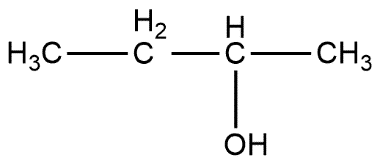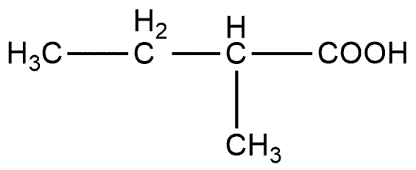
2-butanol is converted into 2-methylbutanoic acid by:
A. (i) Cu (ii) HCN (iii)
B. (i) HCN (ii)
C. (i)
D. (i) KCN (ii)
Answer
442.8k+ views
Hint: Butanol is a molecule containing 4 carbon atoms along with an alcoholic group that’s why the suffix ol is attached with it. While butanoic acid is those compounds in which an acidic group is present.
Complete answer:
Butanol is primarily used as a solvent and as an intermediate in chemical synthesis and also used as a fuel. 2-butanol describes the position of alcoholic group i.e. OH group is present on 2nd carbon atom which can be shown as:

2-methylbutanoic acid tells that a 2nd carbon methyl group is attached and an acidic group is present on the first position. It exists in two enantiomeric forms which are defined as (R) and (S)-2-methylbutanoic acid. (R)-2-methylbutanoic acid occurs naturally in cocoa beans and (S)-2-methylbutanoic is present in many fruits such as apples and apricots.

2-butanol is converted into 2-methylbutanoic acid step by step:
Ist step converts 2-butanol to 2-chlorobutane

In second step, 2-chlorobutane reacts with KCN and get Cl group get replaced with CN group which can be shown as:

In third step, it reacts with

Thus we can say that option C is the correct answer.
Note:
2-methylbutanoic acid is a slightly volatile, colorless liquid with a pungent cheesy odor. The smell differs significantly between the two enantiomeric forms i.e. (S)-2-Methylbutyric acid has a pleasantly sweet, fruity odor while (R)-2-methylbutanoic acid has a cheesy, sweaty odor. The main use of the materials and their esters used as flavours and food additives.
Complete answer:
Butanol is primarily used as a solvent and as an intermediate in chemical synthesis and also used as a fuel. 2-butanol describes the position of alcoholic group i.e. OH group is present on 2nd carbon atom which can be shown as:

2-methylbutanoic acid tells that a 2nd carbon methyl group is attached and an acidic group is present on the first position. It exists in two enantiomeric forms which are defined as (R) and (S)-2-methylbutanoic acid. (R)-2-methylbutanoic acid occurs naturally in cocoa beans and (S)-2-methylbutanoic is present in many fruits such as apples and apricots.

2-butanol is converted into 2-methylbutanoic acid step by step:
Ist step converts 2-butanol to 2-chlorobutane

In second step, 2-chlorobutane reacts with KCN and get Cl group get replaced with CN group which can be shown as:

In third step, it reacts with

Thus we can say that option C is the correct answer.
Note:
2-methylbutanoic acid is a slightly volatile, colorless liquid with a pungent cheesy odor. The smell differs significantly between the two enantiomeric forms i.e. (S)-2-Methylbutyric acid has a pleasantly sweet, fruity odor while (R)-2-methylbutanoic acid has a cheesy, sweaty odor. The main use of the materials and their esters used as flavours and food additives.
Recently Updated Pages
Master Class 11 Business Studies: Engaging Questions & Answers for Success

Master Class 11 Accountancy: Engaging Questions & Answers for Success

Master Class 11 Computer Science: Engaging Questions & Answers for Success

Master Class 11 English: Engaging Questions & Answers for Success

Master Class 11 Social Science: Engaging Questions & Answers for Success

Master Class 11 Economics: Engaging Questions & Answers for Success

Trending doubts
Which one is a true fish A Jellyfish B Starfish C Dogfish class 11 biology CBSE

State and prove Bernoullis theorem class 11 physics CBSE

1 ton equals to A 100 kg B 1000 kg C 10 kg D 10000 class 11 physics CBSE

In which part of the body the blood is purified oxygenation class 11 biology CBSE

One Metric ton is equal to kg A 10000 B 1000 C 100 class 11 physics CBSE

Difference Between Prokaryotic Cells and Eukaryotic Cells




